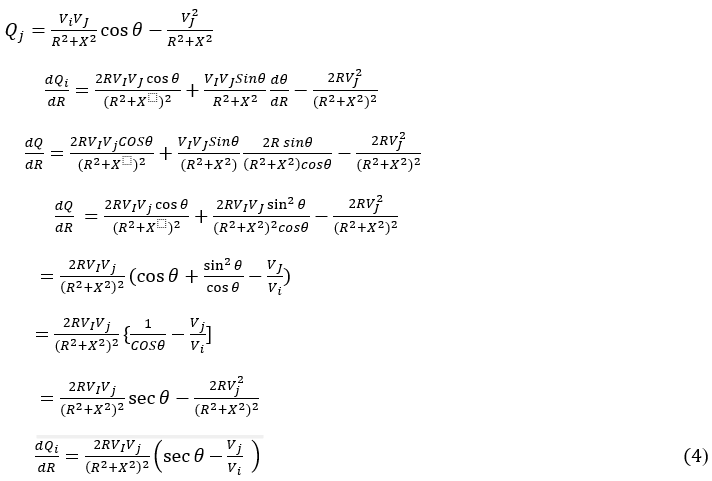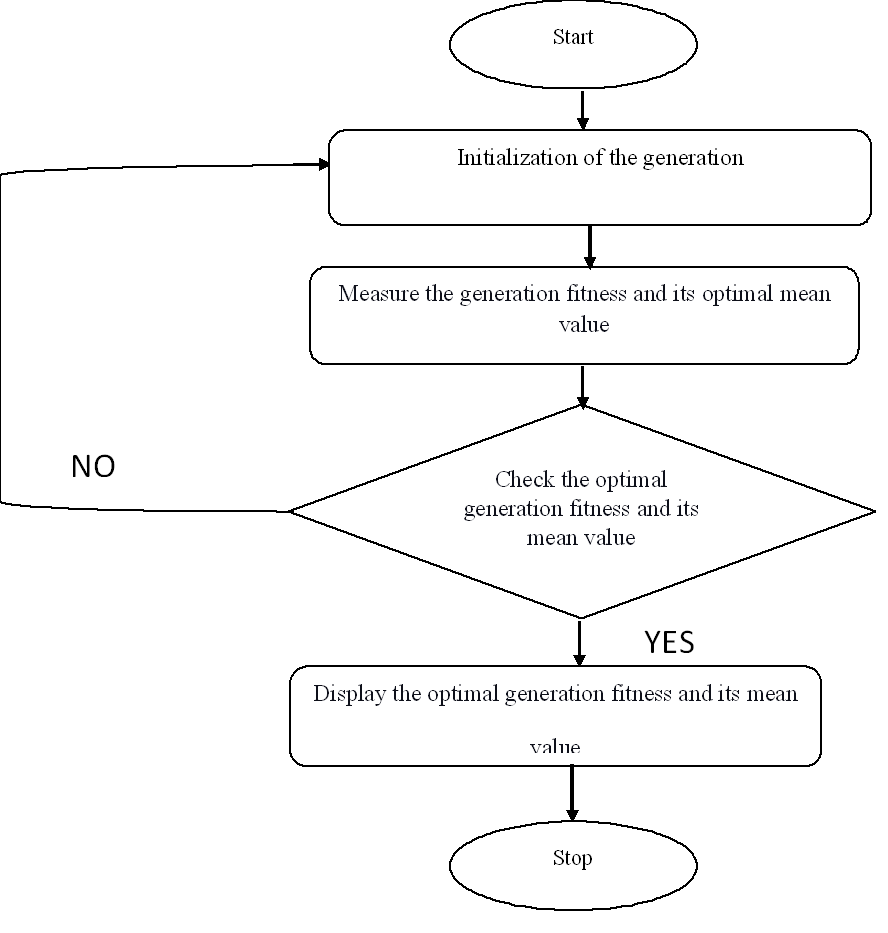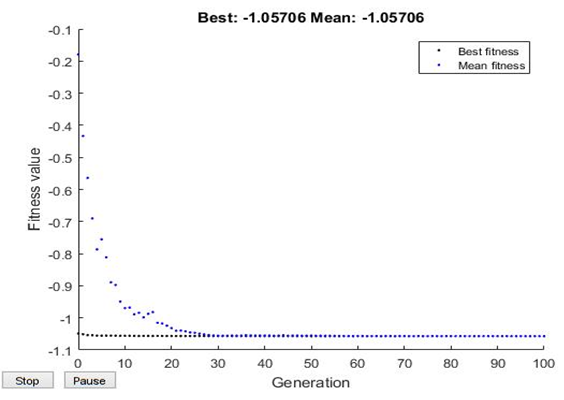Multi-Objective Genetic Algorithm Optimization of Thermal Limit Parameters for Low-Frequency Oscillation Control in Power Systems
- Aliyu Abubakar
- Mohammad Buhari Mohammad
- 536-540
- Jun 26, 2024
- Electrical Engineering
Multi-Objective Genetic Algorithm Optimization of Thermal Limit Parameters for Low-Frequency Oscillation Control in Power Systems
Aliyu Abubakar, Mohammad Buhari Mohammad
Department of Electrical and Electronics Engineering Federal Polytechnic, Bali Taraba State
DOI : https://doi.org/10.51584/IJRIAS.2024.905047
Received: 26 April 2024; Revised: 14 May 2024; Accepted: 20 May 2024; Published: 26 June 2024
ABSTRACT
This work presents the optimization of thermal limit parameters constraint using a multi-objective genetic algorithm. By optimizing the constraint parameters of the formulated objective function, the power transfer capabilities of the system can be maximized, thereby reducing the chances of oscillations in the power system. The study involves formulating an objective function and constraints, implemented in MATLAB Simulink. Initialization of generation fitness and optimal mean value precedes computation of fitness function and mean value. Fitness values are compared against predefined benchmarks to gauge optimization levels, with verification ensuring mean fitness meets a predetermined threshold. Achieving the threshold to 1.05706 resulted to better power transfer efficiency by decreasing oscillations that previously impacted power stability. Optimized thermal limit parameters enhance power transfer capabilities, minimizing oscillations, ensuring stable operation, and reducing the risk of system instability.
Keywords: algorithm ,genetic, limit, multi-objective, optimization, parameters power system ,thermal limit
INTRODUCTION
Power systems are crucial for meeting the constantly growing demands of modern society (. et al., 2019). However, their stability and reliability are often threatened by various factors, such as oscillations that can lead to disruptions and failures (Farahani et al., 2011). These oscillations can be caused by sudden changes in demand, faults, or fluctuations in renewable energy generation (Zhu et al., 2018). They pose significant risks to the stability and resilience of power grids, highlighting the need for effective mitigation strategies (Falehi, 2020). One promising approach to mitigate oscillation risks in power systems is optimizing thermal limits that govern the maximum allowable power flow through transmission line equipment, ensuring that they operate within safe operating conditions (Mohanty, 2019). By optimizing these parameters, power system operators can better manage the balance between maximum transmission capacity and minimizing the risk of overloading, thereby reducing the likelihood of oscillations (Ray et al., 2018). To tackle the challenges, optimizing thermal limit parameters for oscillation risk reduction is essentially needed (Khamees et al., 2017). Genetic algorithms are powerful optimization techniques inspired by the process of natural selection and evolution (Falehi, 2020). They excel at finding near-optimal solutions to complex, nonlinear problems by iteratively evolving a population of potential solutions (Nikzad et al., 2011).
1.1 The objective function formulation of a thermal limit for power system
Consider the case of power transmission over a lossless line. Let Vi and VJ be the sending end and receiving end voltages Where θ=θi-θj is the phase angle, R, X are the resistance and reactance respectively. The real and the reactive power at the receiving end are given as (Sokolov et al., 2022).
From equation (1) above using
Therefore
From equation (1) above using (Falehi, 2020)
The objective function of the above equation is given as (Xu et al., 2018)
And the constraint of the above equation is given as (Falehi, 2020)
The study proposes the use of a multi-objective genetic algorithm to maximize power transfer capabilities and reduce oscillation risk in power systems (Setiadi & Jones, 2016).
2.1 Material:
MATLAB Simulink, Optimization Tool
2.2 Method
The process bio-inspired optimization involves formulating an objective function and constraint, which are then implemented in MATLAB Simulink for code development. The generation fitness and optimal mean value are initialized, and the fitness function and mean value are computed. The fitness values are then compared against predetermined benchmarks to assess the optimization levels. Verification is done to ensure that the mean fitness meets a predefined threshold. This threshold value facilitates enhanced power transfer capabilities by reducing oscillations and ensuring better performance of the power system
Fig 1 flowchart of multi-objective optimization thermal limit algorithms
RESULTS AND DISCUSSION
3.1 Results
The multi-objective genetic algorithm (MOGA) has shown promising results in optimizing thermal limit constraint parameters in power systems. Extensive simulations and analysis have demonstrated significant improvements in system performance across multiple objectives, including enhanced grid reliability and minimized thermal stress on critical components. The MOGA has successfully identified a set of optimal parameter values that strike a balance between various conflicting objectives, thereby optimizing the thermal limit constraints to maximize power transfer capabilities which improved the chances of reducing oscillations in power system. The optimization results indicate that the fitness and optimal mean value of the multi-objective thermal limit parameters converge rapidly to a value of 1.05706. However, a negative value appearing on the optimization graph typically indicates a limitation of the algorithm itself. Further analysis is needed to understand the reasons behind the negative value and devise strategies for improvement.
Fig 2 is the graph which indicates the optimized multi-objective thermal limit parameters and its optimal mean value evaluated as 1.05706.
DISCUSSION
The study shows the effectiveness of using a multi-objective approach that utilizes genetic algorithms to tackle the complicated optimization problem of thermal limit constraint parameters in power systems. By considering multiple conflicting objectives at the same time, the MOGA was able to explore a wide range of solutions and identify trade-offs that traditional single-objective optimization methods might overlook. Furthermore, the flexibility and adaptability of genetic algorithms allowed for the inclusion of various system constraints and uncertainties, resulting in reliable and robust solutions customized to specific operational scenarios.
CONCLUSION
The use of a multi-objective genetic algorithm to optimize thermal limit constraint parameters in power systems is a promising approach for optimization of thermal limit parameters enhance power transfer capabilities, minimizing oscillations, ensuring stable operation, and reducing the risk of system instability. The results highlight the importance of considering multiple objectives and system constraints during the optimization process, leading to more robust and efficient solutions. Going forward, more research and development efforts should be focused on refining the MOGA methodology, addressing scalability challenges, and exploring its applicability in real-world power system operation and planning. Overall, this study contributes to advancing the state-of-the-art in power system optimization and lays the groundwork for future advancements in grid management and sustainability.
REFERENCES
- F. A., . S. H., & . G. K. P. (2019). Optimization Techniques in Power System: Review. International Journal of Engineering Applied Sciences and Technology, 3(10), 8–16. https://doi.org/10.33564/ijeast.2019.v03i10.003
- Falehi, A. D. (2020). Optimal robust disturbance observer based sliding mode controller using multi ‑ objective grasshopper optimization algorithm to enhance power system stability. Journal of Ambient Intelligence and Humanized Computing, 0123456789. https://doi.org/10.1007/s12652-020-01811-8
- Farahani, S. S. S., Nikzad, M., Tabar, M. B., Naraghi, M. G., & Javadian, A. (2011). Dynamic stability enhancement and voltage support using upfc tuned genetic algorithms in a multimachine environment. International Journal of Physical Sciences, 6(22), 5273–5280. https://doi.org/10.5897/IJPS11.833
- Khamees, A. K., El-Rafei, A., Badra, N. M., & Abdelaziz, A. Y. (2017). Solution of optimal power flow using evolutionary-based algorithms. International Journal of Engineering, Science and Technology, 9(1), 55–68. https://doi.org/10.4314/ijest.v9i1.5
- Mohanty, B. (2019). Hybrid flower pollination and pattern search algorithm optimized sliding mode controller for deregulated AGC system. Journal of Ambient Intelligence and Humanized Computing, 0123456789. https://doi.org/10.1007/s12652-019-01348-5
- Nikzad, M., Farahani, S. S. S., Naraghi, M. G., Tabar, M. B., & Javadian, A. (2011). Voltage support and stability improvement using unified power flow controller tuned based on simulated annealing. International Journal of Physical Sciences, 6(20), 4781–4789. https://doi.org/10.5897/IJPS11.835
- Ray, P. K., Paital, S. R., Mohanty, A., Eddy, F. Y. S., & Gooi, H. (2018). A robust power system stabilizer for enhancement of stability in power system using adaptive fuzzy sliding mode control. Applied Soft Computing Journal, 73, 471–481. https://doi.org/10.1016/j.asoc.2018.08.033
- Setiadi, H., & Jones, K. O. (2016). Power system design using firefly algorithm for dynamic stability enhancement. Indonesian Journal of Electrical Engineering and Computer Science, 1(3), 446–455. https://doi.org/10.11591/ijeecs.v1.i3.pp446-455
- Sokolov, A. A., Fomenko, O. A., & Ignatev, I. V. (2022). Development of algorithms for control and control of electric power parameters based on information-measuring system data. Journal of Physics: Conference Series, 2176(1). https://doi.org/10.1088/1742-6596/2176/1/012076
- Xu, G., Cheng, H., Fang, S., Ma, Z., Zeng, P., & Yao, L. (2018). Optimal Size and Location of Battery Energy Storage Systems for Reducing the Wind Power Curtailments. Electric Power Components and Systems, 46(3), 342–352. https://doi.org/10.1080/15325008.2018.1445141
- Zhu, Y., Liu, C., Wang, B., & Sun, K. (2018). Damping control for a target oscillation mode using battery energy storage. Journal of Modern Power Systems and Clean Energy, 6(4), 833–845. https://doi.org/10.1007/s40565-017-0371-3






